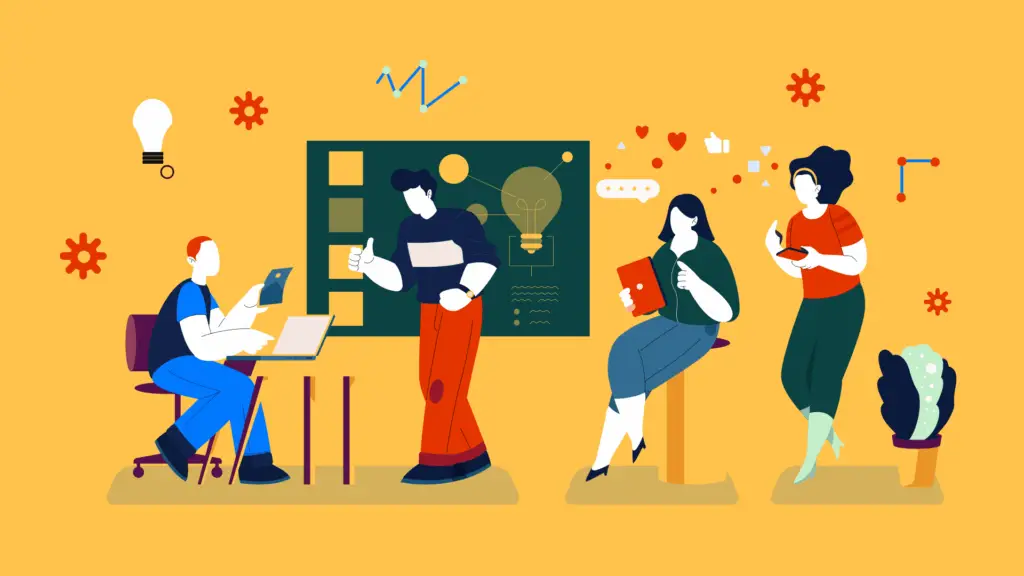We need to involve designers at every stage because creative marketing projects that aren’t informed by design strategy, or design thinking, are more likely to miss the mark.
In this article, we’re exploring why design collaboration – between designers and marketers – could well be the missing ticket you need for a successful campaign, product or launch.
Then, tips for making marketing and design collaboration work efficiently within your own teams.
Why should marketers and designers collaborate on projects?
Design shouldn’t come in after the strategy. Much like the strategy shouldn’t be finalised without design thinking. Each influence the other.
Both designers and marketers need to understand who is using/viewing/interacting with the end product to make it valuable. Both work to determine the most effective way of reaching the end goal.
Because at the end of the day, the end goals for marketers and designers are the same, for any project, however you phrase it: high performance and high customer satisfaction.
Clever, targeted and strategic campaigns won’t convert without user-friendly design. Stunning designs won’t help anyone if there’s no defined message, goal or next step to take.
The two go hand in hand. But often, the two don’t come together early enough in the process meaning projects take longer, cost more, or fall short of the results wanted.

The benefits of collaborative design
- Marketers understand the target customer, and how to reach them, inside out.
- Designers understand how to design for a specific goal or outcome, and bring a vision to life.
When the two work together at the same time, you get a hyper-targeted product or campaign that’s specifically designed to appeal to the end user.
How to make marketer-designer collaboration more effective:
The main issue when designers and marketers come together? Communication.
A lack of design systems often makes feedback or briefing disjointed. When asked about reasons for workplace failure, 86% of people surveyed by Fierce Inc. cited lack of communication as the main culprit, so aim to make conversation simple.
Marketers and designers often have different ways of communicating within their teams, but for design collaboration to be effective, you need to centralize how they brief, feedback, and amend – even if the work is happening remotely.
1. Establish trust
Both marketers and designers are highly skilled in their unique roles.
Accept that both sides of the party bring valid and important information and perspective, to avoid confrontation and stress.
Remember: a campaign or design project is about the end-user.
You know that business won’t work without consumer trust, but this applies internally, too.
“A team is not a group of people who work together. A team is a group of people who trust each other.” – Simon Sinek
Be a team.
2. Understand your strengths (and weaknesses)
As with the above point, both teams bring unique skillsets to the table.
When working collaboratively on any project, it’s important to understand where these skills lie, and with whom, to go from strategy to design delivery without a hitch.
Marketers will be better at understanding the data and defining the next steps, to pinpoint a specific message that will make the most impact on the market.
Designers, on the other hand, use this data to build and tailor a product or service to the target user, bringing valuable insight on how to best package the specific message the marketer has developed.
On the flip side, know where the weaknesses are and delegate tasks accordingly.
The marketer may not be the best person to decide on the design hierarchy of an advert but may have insight into what information is the priority.
3. Create a centralized location
One of the most frustrating things when working across teams is the endless back and forth, email chains and disjointed or lost files. It slows things down and causes deadlines to be missed (and budgets creep up).
To create a seamless experience for both parties, having a centralized system or location to store the entire project will make the process much simpler.
While there are multiple project management and design collaboration tools out there to choose from (we wrote about some of our favorites), the key is to choose something that is accessible to everyone, from anywhere.
There’s no point in using a techy design platform if your marketers can’t access it or figure out how to add a comment.
Look for a tool that allows for file storage and real-time feedback so things don’t get lost in an inbox somewhere.
4. Organize, organize, organize
We can’t stress this point enough. Organization is vital within any project, but even more when two departments collide.
It’s essential that anyone working on a project has access to what they need, when they need it. And simply.
Keep projects organized into folders, split into the various assets required, such as social media graphics, banner artwork or landing page mockups.
5. Determine the workflow
Ensure that it’s completely clear who is owning what part of the process, who needs feedback from whom and by when.
Who is responsible for what?
This comes down to having a strong brief from the marketers to the designers, and collaborative designing from the designers as they go.
6. Encourage real-time feedback – and be specific
It’s easy to forget that not everyone understands industry speak. Even if you work for the same company, what may seem like normal language to you in design, may sound like gobbledegook to them in marketing.
Avoid jargon; speak like a human.
If you’re finding that there’s friction between the teams when amendments are needed, aim to provide feedback in context to the objective. How will the change benefit the customer or end user?
Remember, you’re both skilled teams, but you’re not mindreaders. Be clear with feedback and prospected deadlines no matter which team you’re on.
Design collaboration is a huge part of our work here at Design Force, which is why we’ve successfully designed for teams at Hubspot, UFC Gym, and TikTok!
Are you a marketer looking for designers to collaborate with on your next project? Get in touch today and have world-class designers at your fingertips tomorrow!



